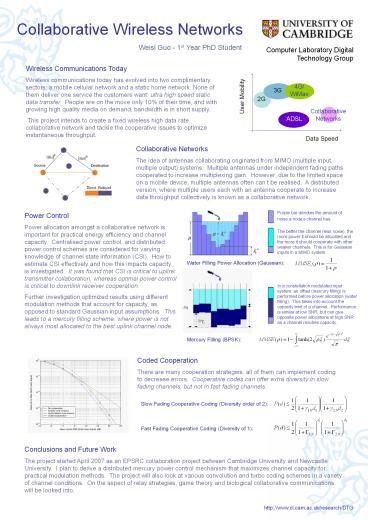Collaborative Wireless Networks PowerPoint PPT Presentation
1 / 1
Title: Collaborative Wireless Networks
1
Collaborative Wireless Networks
Weisi Guo - 1st Year PhD Student
Computer Laboratory Digital Technology Group
Wireless Communications Today Wireless
communications today has evolved into two
complimentary sectors a mobile cellular network
and a static home network. None of them deliver
one service the customers want ultra high speed
static data transfer. People are on the move
only 10 of their time, and with growing high
quality media on demand, bandwidth is in short
supply. This project intends to create a fixed
wireless high data rate collaborative network and
tackle the cooperative issues to optimize
instantaneous throughput.
4G/ WiMax
3G
User Mobility
2G
Collaborative Networks
ADSL
Data Speed
Collaborative Networks The idea of antennas
collaborating originated from MIMO (multiple
input, multiple output) systems. Multiple
antennas under independent fading paths
cooperated to increase multiplexing gain.
However, due to the limited space on a mobile
device, multiple antennas often cant be
realised. A distributed version, where multiple
users each with an antenna cooperate to increase
data throughput collectively is known as a
collaborative network.
Purple bar denotes the amount of noise a nodes
channel has.
Power Control Power allocation amongst a
collaborative network is important for practical
energy efficiency and channel capacity.
Centralised power control, and distributed power
control schemes are considered for varying
knowledge of channel state information (CSI).
How to estimate CSI effectively and how this
impacts capacity is investigated. It was found
that CSI is critical to uplink transmitter
collaboration, whereas optimal power control is
critical to downlink receiver cooperation.
Further investigation optimized results using
different modulation methods that account for
capacity, as opposed to standard Gaussian input
assumptions. This leads to a mercury filling
scheme, where power is not always most allocated
to the best uplink channel node.
The better the channel (less noise), the more
power it should be allocated and the more it
should cooperate with other weaker channels.
This is for Gaussian inputs in a MIMO system.
Water Filling Power Allocation (Gaussian)
In a constellation modulated input system an
offset (mercury filling) is performed before
power allocation (water filling). This takes
into account the capacity limit of a channel.
Performance is similar at low SNR, but can give
opposite power allocations at high SNR as a
channel reaches capacity.
Mercury Filling (BPSK)
Coded Cooperation There are many cooperation
strategies, all of them can implement coding to
decrease errors. Cooperative codes can offer
extra diversity in slow fading channels, but not
in fast fading channels.
Slow Fading Cooperative Coding (Diversity order
of 2)
Fast Fading Cooperative Coding (Diversity of 1)
Conclusions and Future Work The project started
April 2007 as an EPSRC collaboration project
between Cambridge University and Newcastle
University. I plan to derive a distributed
mercury power control mechanism that maximizes
channel capacity for practical modulation
methods. The project will also look at various
convolution and turbo coding schemes in a variety
of channel conditions. On the aspect of relay
strategies, game theory and biological
collaborative communications will be looked into.
http//www.cl.cam.ac.uk/research/DTG

